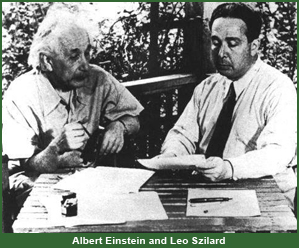
Time Periods
1890s-1939:
Atomic Discoveries
1939-1942:
Early
Government Support
1942-1944:
The Uranium
Path to
the Bomb
1942-1944:
The Plutonium
Path to
the Bomb
|
On October 11, 1939, Alexander Sachs, Wall Street economist and longtime friend and unofficial advisor to President Franklin Delano Roosevelt, met with the President to discuss a letter written by Albert Einstein the previous August (right). Einstein had written to inform Roosevelt that recent research on fission chain reactions utilizing uranium made it probable that large amounts of power could be produced by a chain reaction and that, by harnessing this power, the construction of "extremely powerful bombs" was conceivable. Einstein believed the German government was actively supporting research in this area and urged the United States government to do likewise. Sachs read from a cover letter he had prepared and briefed Roosevelt on the main points contained in Einstein's letter. Initially the President was noncommittal and expressed concern over locating the necessary funds, but at a second meeting over breakfast the next morning Roosevelt became convinced of the value of exploring atomic energy.
Sources and notes for this page. The text for this page was adapted from, and portions were taken directly from the Office of History and Heritage Resources, publication: F. G. Gosling, The Manhattan Project: Making the Atomic Bomb (DOE/MA-0001; Washington: History Division, Department of Energy, January 1999), vii. Click here for more information on the photograph of the letter. The photograph of Albert Einstein with Leo Szilard is courtesy the Federation of American Scientists. The portrait of Franklin Roosevelt is courtesy the Center for the Study of Intelligence, Central Intelligence Agency.
Home |
History Office
|
OpenNet
|
DOE
|
Privacy and Security Notices |



